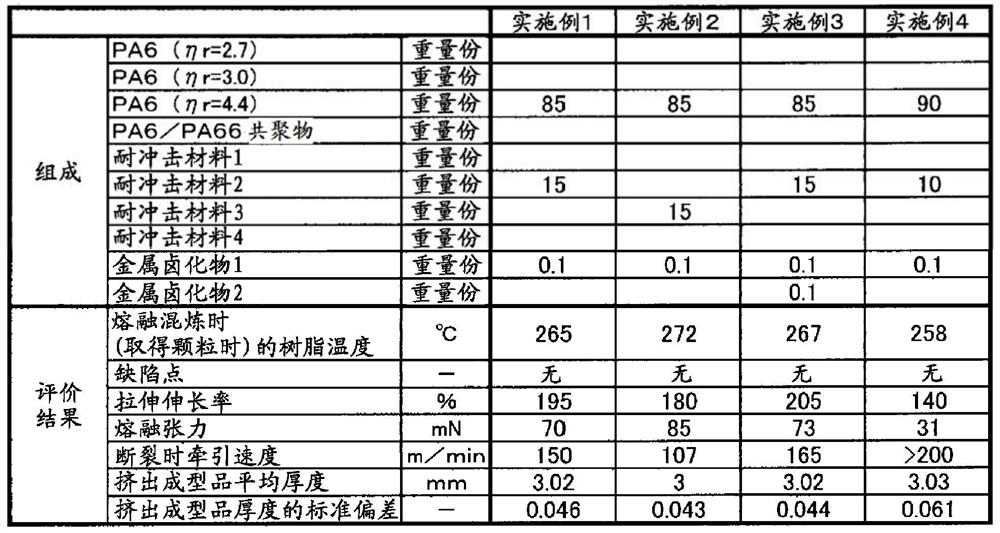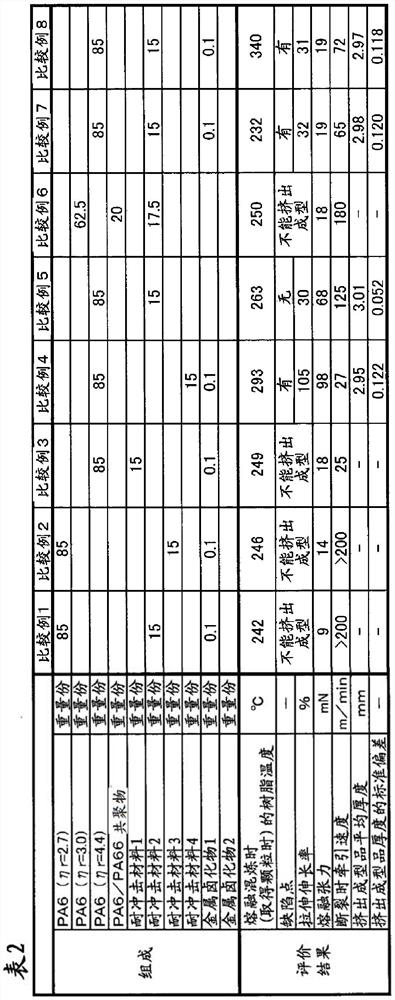Polyamide resin composition for extrusion molded products exposed to high-pressure hydrogen, and extrusion molded product
A technology of polyamide resin and molded products, applied in the field of extrusion molded products, can solve problems such as damage, tank deformation, and increased accumulation, and achieve the effects of fast traction speed, small thickness unevenness, and excellent sag resistance
- Summary
- Abstract
- Description
- Claims
- Application Information
AI Technical Summary
Problems solved by technology
Method used
Image
Examples
Embodiment 1~4、 comparative example 4、5
[0120] Each raw material described in Tables 1 and 2 was supplied to a twin-screw extruder (TEX30α- 35BW-7V) (L / D = 45 (In addition, L here is the length from the raw material supply port to the discharge port, and D is the diameter of the screw.)) and melt-kneaded. The strips discharged from the die at a speed of 20kg / h were quenched by passing through a cooling bath filled with water at a temperature of 10°C for 10 seconds, and then pelletized with a strand pelletizer to obtain particles. The obtained granules were vacuum-dried at a temperature of 80° C. for 12 hours with a vacuum dryer to obtain dried granules. From the obtained pellets, extrude from a die at an extrusion temperature of 260°C using an extruder, pass through a shaping die, cool, and extrude into a tubular extruded product with an outer diameter of 100 mm and an inner diameter of 94 mm. . About thickness, average thickness x was calculated|required from Formula 1), and the result is described in Table 1,2....
Embodiment 1
[0121] In Example 1, kneading was carried out with a composition of 85 parts by weight of PA6 (ηr=4.4) as polyamide 6 resin (A), 15 parts by weight of impact-resistant material 2 and 0.1 part by weight of metal halide 1 . The resin temperature during melt-kneading was 265°C. The average dispersion diameter of the impact-resistant material 2 obtained was 0.13 μm, and the particles were finely dispersed. In addition, the melt tension of the obtained pellets was 70 mN, and the pulling speed at breakage was 150 m / min, which were favorable. The extruded product had no defects, and the standard deviation of the thickness of the extruded product was 0.046, which was favorable.
Embodiment 2
[0122] In Example 2, the impact-resistant material 2 of Example 1 was changed into the impact-resistant material 3, and it was the same as Example 1 except that. The resin temperature during melt-kneading was 272°C. The melt tension of the obtained pellets was 85 mN, and the pulling speed at breakage was good at 107 m / min. The extruded product had no defects, and the standard deviation of the thickness of the extruded product was 0.043, which was good.
PUM
| Property | Measurement | Unit |
|---|---|---|
| tension | aaaaa | aaaaa |
| tension | aaaaa | aaaaa |
| melting point | aaaaa | aaaaa |
Abstract
Description
Claims
Application Information
 Login to View More
Login to View More - R&D
- Intellectual Property
- Life Sciences
- Materials
- Tech Scout
- Unparalleled Data Quality
- Higher Quality Content
- 60% Fewer Hallucinations
Browse by: Latest US Patents, China's latest patents, Technical Efficacy Thesaurus, Application Domain, Technology Topic, Popular Technical Reports.
© 2025 PatSnap. All rights reserved.Legal|Privacy policy|Modern Slavery Act Transparency Statement|Sitemap|About US| Contact US: help@patsnap.com


